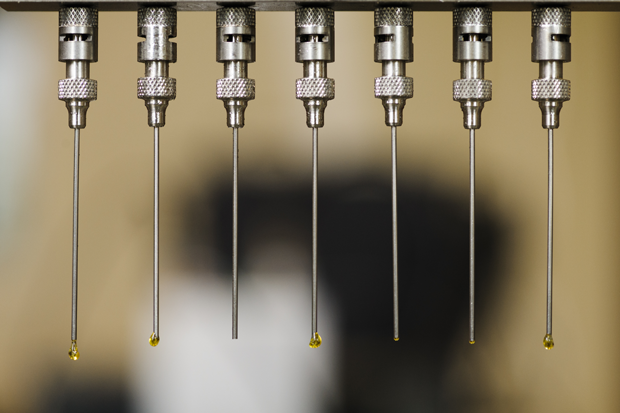What George Washington Carver did for the lowly peanut, a quartet of scientists at the University of Alabama hopes to do for smelly shrimp shells.
Carver urged farmers to grow crops other than cotton, particularly peanuts, which could be a source of food and other products to improve their quality of life.
“You have a waste product that the fishermen are paying to get rid of, and they want to make any profit they can from it, ” says Robin Rogers, former Robert Ramsey chair of chemistry at UA. “You can sell it for fertilizer for pennies a pound but we have a way to extract polymer out of the shrimp shell that nobody in the world has, and that polymer, because of the way we can manipulate it, can make thousands of materials, new products, for different uses and different applications.”
Rogers is founder, owner and president of 525 Solutions, a University of Alabama start-up company. Last year, the company received a $1.5 million grant from the U.S. Department of Energy to refine an alternative material that holds the possibility of extracting uranium from the ocean using a medium that is extracted from shrimp shells. In addition to Rogers, the UA/525 Solutions team includes Gabriela Gurau, former chief executive officer now chief financial officer; Julia Shamshina, chief technology officer, and Ronnie Hanes, chief executive officer, a veteran with 30 years research experience in the chemical industry. All are UA graduates and all hold doctorate degrees.
“We started 525 Solutions as a way to take fundamental faculty inventions and ideas and put them into the general realm of sustainability, ” Rogers says.
“When the BP oil spill happened, the shrimpers were kind of being put out of business and we had just been looking at a new laboratory curiosity that allowed us to extract a valuable polymer called chitin from shrimp shells, ” Rogers says. Pronounced “ky-tin, ” chitin is a tough, semi-transparent substance that is the main component of the exoskeletons of crustaceans, insects and their kin.
The shrimpers were drying their discarded shells and selling them for fertilizer at some “ridiculously low price per ton, ” says Rogers. 525 Solution’s chitin extraction project, once under way, would add value to the shrimp business and create a new industry for the state of Alabama, Rogers adds.
“My statement to the Gulf Coast Agricultural and Seafood Co-op then, I think it is true today, was that the waste from the shrimp is more valuable than the meat.” Rogers says. “It’s just a matter of having the technology in place to exploit it, and we have developed a way to extract the chitin.”
The original government grant was to refine an adsorbent, biodegradable material made from chitin, which, when formed into sheets and suspended in the ocean, would draw uranium, which would then be removed chemically from the sheets. The “farms” would be similar to the kelp forests.
Uranium is just one metal, Rogers says, and “we can do any metal, so our adsorbents could go into cleaning up fracking fluids, mining, remediation, so you can think about filters, purification and metal ion extraction. Uranium was just the one we were paid by the grant to do, but the technology is perfectly amenable to any target, including gold.”
Rogers says the UA team is now beyond the uranium extraction for the most part. “The uranium extraction is what is paying the bills to allow us to scale up the extraction and electro spinning of chitin, ” he says.
“The likelihood of mining uranium from the ocean in our lifetime is actually very low. Our business model to the government was essentially that we are going to prove that we can do this. We are going to scale it up to allow us to make all these other products that will keep the company going and when the government needs the technology in the future, we will be able to provide it.”

|
“We have leveraged the DOE grant to give them the deliverables we promised so there is an adsorbent that can take uranium out of sea water, but the basics for that has allowed us to build a platform to extract chitin and begin to build businesses around that. Downstream products and derivatives of chitin are starting to be built in-house, ” says Hanes.
Rogers says the company’s next step is to build a plant to extract the polymer from the shells. “We can sell the polymer to get cash flow, but what we want to do, because we are inventors, we want to make sutures, bandages, metal adsorbents, beverage bottles, all these polymer products that today are oil-based.”
“We are scaling up the extraction and getting all of the numbers that we need to build a plant, ” Rogers says. “We are ready to get started, and we would like for it to be a synergistic interaction with the co-op.
“What we are talking about doing for our fishing industry in Alabama is to have a second revenue stream that would be as valuable as or more valuable than the shrimp.”
Chitin worldwide is a $63 billion industry, but there is no chitin producing plant in the United States or North America because the current process is environmentally hazardous, according to Rogers.
“All of our work has been in green chemistry or sustainability. We have a new method, we have it patented, and we have the technology. This grant has allowed us to put everything together.”
“But the first thing we have to do is get a large enough supply of this polymer, this chitin, to make all these different products efficiently and start those businesses.
“We discovered a liquid salt that would dissolve chitin. We can actually take the natural polymer as nature has made it and dissolve it, and once we get in a solution we can make anything we want.”
Are there enough shrimp shells to make this work?
“To get started in Alabama, yes, ” Rogers says. “But if we do all the things we want to do, no. But if we were to build a second plant in Louisiana, where the shrimp haul is four to five times that of Alabama, yes. And there is enough in the United States.” The group has visited Alaska, California, Maine and other coastal areas to gauge interest in the project.
John Grevenitis, president of the Gulf Coast Agricultural and Seafood Co-op in Bayou La Batre, says his organization has been talking with 525 Solutions for about five years and would welcome a chitin extraction plant in that area.
“We certainly are interested in what the group at UA is doing. Right now, we render down the shells, dry them out, sell them in bulk for fertilizer. It would be good to have a plant or something here where we don’t have to freight the shells. If they get up and going, we have plenty of room for them to build a facility, ” Grevenitis says.
“What we can do today, ” Rogers says, “is start this concept for a chitin economy for Alabama — new material products from shrimp waste.”
The UA group has a prospectus for possible investors. Rogers says, “We need to find $7 million in either guaranteed loans or investments to build a plant. This is like George Washington Carver getting the first farmer to plant the peanuts.”
Bill Gerdes and Barry Fikes are freelance contributors to Business Alabama. Gerdes is based in McCalla and Fikes in Tuscaloosa.
Text by Bill Gerdes • Photo by Barry Fikes



